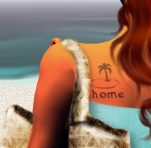|
TOPIC: Anxiety – Overwhelming, Uncontrollable, Unfounded |
PANIC!
Sorry, didn’t mean to startle you with all those big, bold caps, nor am I suggesting that this is what you should do today. However, if even reading the word caused your heart to race just a bit, you have experienced in small measure a disorder that takes over and destroys many people’s lives. The Encarta World English Dictionary offers this as one definition for the word panic: "A feeling of fear or anxiety . . . that comes on suddenly, is overwhelming, appears to be uncontrollable, and may seem to be unfounded." Most of us who suffer from panic disorder would tell you this definition doesn’t even come close to describing panic. For most of us, panic really equals death. I realize that this sounds like an exaggeration to most normal people. Sadly it is not.
Panic attacks, or panic disorder as it is more accurately named, is only one of a constellation of disorders that revolve around panic and anxiety as their major symptoms. The anxiety disorders have been divided into the following major categories: (1) Social Phobia/Social Anxiety, (2) Generalized Anxiety Disorder (GAD), (3) Specific Phobias, (4) Obsessive-Compulsive Disorder (OCD), (5) Post-Traumatic Stress Disorder (PTSD), and finally, (6) Panic Disorder (with or without Agoraphobia). While I would love to be able to discuss all of them, space and time limitations restrict me to talking about only panic disorder – and since I am also a sufferer, this is the one I feel most competent to discuss.
Panic disorder typically begins to surface sometime in the late teens or early twenties, but it has been found to begin much earlier in childhood for some people or much later. Over 19 million Americans suffer from some type of anxiety disorder or will suffer with one during their lifetimes. These disorders are expensive – $42.3 billion dollars is spent annually in direct and indirect costs in the U. S. alone (1990 dollars). Twice as many women suffer from these disorders as men, although researchers are not sure whether this statistic reflects accurate numbers or whether men are just less willing to present themselves for treatment and turn to drugs or alcohol to try to self-medicate for this condition.
Ask a person with panic disorder to describe it and they will almost always respond that it is “the most terrifying experience I’ve ever had.” Without provocation, sufferers experience the same emotional and/or physical sensations they would if their lives were in jeopardy. No amount of reassurance can convince us that what we feel is not real, mainly because what we feel is very real. The most common symptoms of panic disorder include, but are not limited to, the following: heart palpitations; increase in blood pressure; sweating; fear of dying, losing control, and/or going crazy; chest pains; feelings of faintness or dizziness; trembling; hot/cold flashes; shortness of breath; choking; nausea; tingling and/or weakness in the extremities; and feelings of what can only be described as “unreality.” Needless to say, it is a miserable and emotionally devastating condition. Many sufferers lose a great deal of independence along with their self-esteem and sense of self.
These sensations of panic come out of the blue; most often, they can not be attributed to any specific source. However, certain illnesses can mimic panic disorder and all people who have experienced these sensations should be tested by their physicians to rule out any other underlying physical disease process (like hyperactive thyroid, heart disease, and many other conditions). Substances can also trigger panic attacks; these substances include caffeine, some prescription medicines, illegal drugs, etc. Fear of a specific object or situation can bring on a panic attack too.
Panic disorder frequently occurs in combination with something known as agoraphobia, which is Greek for “fear of the market.” Agoraphobia can be briefly described as fear of being in public places from which escape would be impossible or difficult. Paradoxically, most agoraphobics are also afraid of being alone. One-third of all people who experience panic attacks go on to develop agoraphobia, although some agoraphobics never have panic attacks, and many people with panic attacks do not develop full-blown agoraphobia. As agoraphobics encounter more and more public situations that bring on anxiety and fear, their circle of “safety” begins to become smaller and smaller. If panic occurs in a restaurant, for instance, they will stop going out to restaurants. Again paradoxically, worry about future panic attacks becomes a preoccupation and can actually bring on the next attack. And so, the agoraphobic goes to fewer and fewer public places in a misguided attempt to keep the panic under control. Many agoraphobics are not only house bound, some have been known to go so far as to limit themselves to one room in their homes or one piece of furniture in a room where they feel safe. One woman I know could not leave her couch – she ate there, slept there, lived there. They become terrified prisoners of their own disease and their own minds. Panic can be more crippling and debilitating than loss of a limb or cancer. I suppose what is most insidious about this disease is that panic itself keeps the sufferer from seeking treatment. Not many people would break an arm, for instance, and just leave it dangling. They would go to the emergency room and receive treatment. Panic is different – the same illness that makes you sick, keeps you sick.
The good news is that there is help for this constellation of disorders. Panic has been found to have some biological components and panic disorder does run in families. Some sufferers do respond to medications, some to different treatment modalities, but the most effective treatment regimen seems to be a combination of therapy and meds. Medications used in panic disorders include the following: Benzodiazepines (Xanax, Valium, Klonopin, etc.); Monoamine Oxidase Inhibitors (MAOIs, including Nardil, Elapryl, Parnate, etc.); Selective Serotonin Reuptake Inhibitors (SSRIs, including Prozac, Paxil, Celexa, Zoloft, etc.); and finally, Tricyclic Antidepressants (TCAs, including Elavil, Sinequan, Tofranil, etc.). I must tell you that while I have tried almost all of these, none has worked for me without significant side effects that I found more troubling than the panic itself. These side effects can range from simple dry mouth, to drowsiness, to much more troubling reactions like irregular heartbeat, diarrhea, constipation, weakness, and many other symptoms too numerous to list. Some people, like me, have even been found to have paradoxical responses to medication; in other words, the medication can actually bring on panic attacks rather than control them. While I would not discourage anyone from trying these medications, I do recommend you proceed with great caution and report any unusual sensations or symptoms to your physician immediately. These medications normally take several weeks to begin working and might need to be taken for a few months to many years. As with all medications, they should be phased out gradually under a doctor’s close supervision if a patient wishes to discontinue them. Please do not ever simply discontinue any medication. The ramifications and consequences of drug withdrawal can be serious or even life-threatening.
In addition to medications, there are many different psychological therapies that have proved successful in the treatment of panic. The most well known, respected, and useful of these is something known as cognitive behavorial therapy. Briefly, in this treatment option, the therapist works with the patient to explore the many situations that cause panic and then the patient is taught to view these situations differently, to think about them in a different way. The mind is being retrained. An off-shoot of cognitive behavioral therapy is something known as exposure therapy. I have found this one exceedingly useful. The therapist exposes the patient to fearful situations. Symptoms of panic can be controlled using learned behavorial techniques such as breathing, focusing, and in some instances, merely waiting for the symptoms of panic to de-escalate. Although it feels as if the panic will escalate until it consumes you, it will not. Panic usually reaches a certain level and then stays there for a while, before it starts to diminish. The patient needs to learn that panic has never escalated into infinity. She must learn to feel the fear and realize it does have limits. As the patients conquer minor fearful situations and gain some measure of confidence (for instance, leaving the home to go to the mailbox at the end of the driveway), the therapist then takes them into increasingly more difficult situations (a busy mall or restaurant, if that’s what they fear) until they become desensitized to these environments. The behavioral therapies work much slower and take greater commitment on the part of the patient, but they are much more beneficial in terms of regaining one’s life. There are no side effects to speak of, and one is not dependent on medication to control the situation. It is most empowering to learn to control panic by yourself rather than depending on medication to do this for you. Many of these medications lose their effectiveness; learning to control panic in your own mind does not.
Oddly enough, just learning that what you have is a recognized disorder can go a long way toward helping you to deal with it. Merely learning that panic will not kill you has given many people the strength they require to try to fight and conquer this disorder. I have found that simply standing my ground in a panic situation has taught me much about the disorder. The symptoms typically subside on their own within 20-30 minutes anyway. Of course, it is the most uncomfortable 20-30 minutes you will ever live through, but the more times you live through it, the shorter these episodes become. Many people have been “cured” of panic simply by learning to stand their ground and not run. I have learned to stand “outside” myself and look on the whole thing as something that is happening to me in the third person. Speaking to yourself intellectually, repeating a mantra, attempting meditation or some other form of “mind over matter” can be very effective techniques. I know – I’ve used them. I can often bring my panic under control within minutes; my best time was 30 seconds. I’m quite proud of that accomplishment.
Because I could not possibly discuss all the information concerning panic attacks and other anxiety disorders, I would like to direct you to the following resource:
 Anxiety Disorder Association of America (ADAA) Anxiety Disorder Association of America (ADAA)
The ADAA offers articles on all the various anxiety disorders including brief explanations of the various types I only mentioned here. In addition, they offer guides to treatment, information on the various medications, materials for people who wish to help a family member with anxiety disorder, consumer resources, general publications you can order, and links to other associations who deal with panic. The ADAA site has message boards and chat forums where you can talk to others who have this problem and share information with them regarding medications, treatments or anything else having to do with these conditions. There is also a section devoted to professionals who wish to know more about anxiety disorders and the ADAA can offer assistance in finding a therapist in your area who specializes in treating these disorders.
I have another rather odd therapy that I use myself that I’d like to share with other panic sufferers. I don’t know whether I dreamed this up or whether it is something other people have found works for them as well. Believe it or not, I wear a rubber band on my left wrist. When I feel the symptoms of panic start to begin, I snap that rubber band on my arm as if my life depends on it. I have found that my brain can either deal with the sensations of pain, or the sensations of panic, but not both. If I cause myself enough pain, the brain is distracted from the panic entirely and the symptoms subside on their own. I have talked to a therapist and he feels that there is some biological reasoning behind this as pain and fear are addressed by different areas of the brain. He sees no reason why I should not do this if it works for me. I pass my “treatment” on to anyone who reads this in case it might also work for you. The only side effect I have noticed from this “therapy” of mine are a few red welts on my wrist. They usually disappear within hours, though, and have caused no long-term complications. I will warn you that other people can be quite curious about why you are wearing a rubber band as a bracelet. I usually laugh with them and try to describe the condition and my therapy as best I can. Most are quite sympathetic when they are told.
And speaking of sympathetic, I encourage all panic sufferers not to suffer in silence. Most of us are exceedingly worried about how we look and act when we are disabled in public by this disorder. I have wept openly, cried out, and even fainted while having panic attacks in public, and done even worse while undergoing exposure therapy (lashed out and even thrown things at my therapist -- panic and fear can force you to do some pretty strange things). A good therapist will remind you that just as you will not die of panic, you will not die of embarrassment either and that whatever happens to you in public will be survivable. Other people's stares can be ignored. Moreover, I have found that if you share information about your disorder with people, they are often more than happy to help in any way they can. This alone has helped me to control my panic disorder. Keeping it to myself, being ashamed of it, only made the condition worse. When I started to talk about it with other people, their care and compassion helped me to learn that this is not something I need to be mortified about. I’ve had people bring me wet cloths and ice (cold also seems to help reduce panic symptoms for me) and even dance or sing with me in the aisles of grocery stores to help distract me from the panic. The panic often subsides in mere minutes since I have learned to allow people to know what is wrong and to help. Other people can be your greatest allies. Learn to trust them and to let them assist when they can. Finding out how empathetic others can be will also restore your faith in humanity. I know it has mine.
If panic has been a problem for you or someone you know, I wish you all the best of luck in your journey through it. Or perhaps it is not luck that I wish for you -- it is more often courage and fortitude that will help you recover. And I assure you – you can journey through it. No, I will never be completely cured of this disorder, but I am no longer a victim of it. Some people (I'm one of them) need to get angry in order to fight. They need to become enraged about the injustice of this condition. I got angry enough to do something about the way that panic was destroying my life by making it so limited. Justified anger can move mountains. Yes, I had to investigate and try many different options that did not work before I found those techniques that did. But there is something out there that works for almost everyone. About 80%-90% of patients respond to something. Desensitization therapy and my crazy rubber bands have given me my life back. Don’t let panic destroy your life. It’s an ugly disease and it’s just not worth it.
Author’s Note: My thanks to the owners of the web site I mentioned above where I found most of the information and statistics for this editorial.
Disclaimer: The information provided in this editorial is for informational purposes only and the author cannot make guarantees of accuracy or the application of this information to any specific individual, nor does she support nor discourage any particular treatment modality. Diagnoses and treatments should be obtained and/or be recommended only by a qualified healthcare practitioner. All patients are encouraged to speak to their doctors first before making any significant changes to their healthcare regimen.
/ ARCHIVE /

|
|
| |
|
|




























































![]()